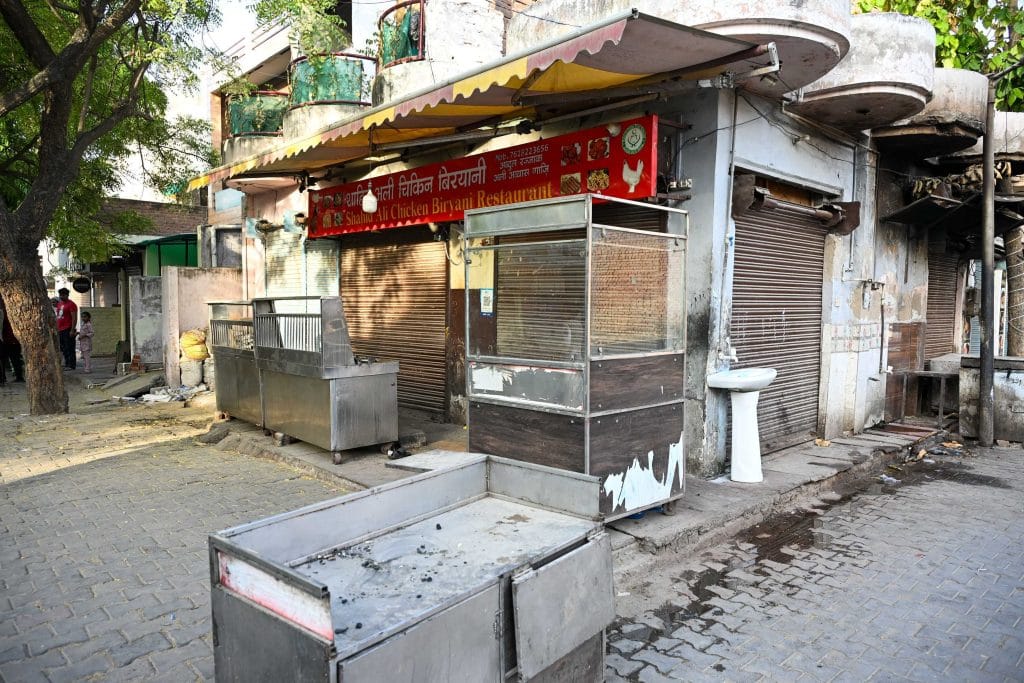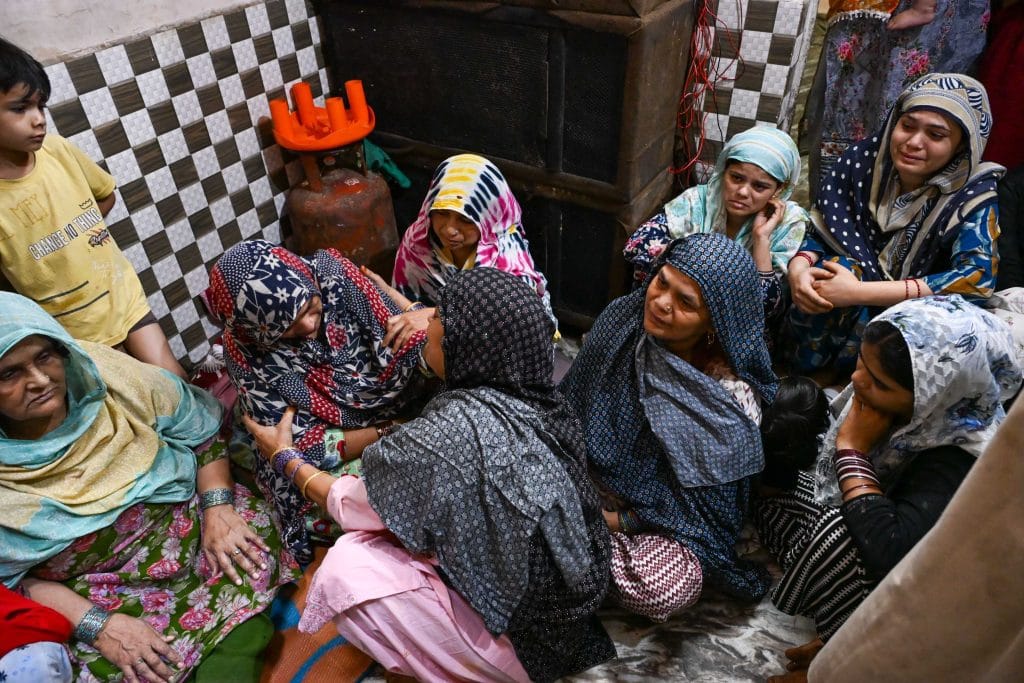Agra: Under the yellow tint of the streetlight, less than 24 hours after the Pahalgam terror attack, 25-year-old Mohammad Ghulfam was preparing to shut Shahid Ali Chicken Biryani restaurant for the night when three men on a motorbike pulled up outside. They looked like late customers. Before Ghulfam could tell them it was closed, one of them raised a gun and fired. Two shots cracked through the night.
Ghulfam’s bloodshot eyes met the shooter’s in confusion, as if asking, Why me? He clutched his chest. Collapsed. A pool of blood spread beneath him.
That is how Saif Ali, his cousin, remembered the night of 23 April. He was sweeping the floor of the family-run restaurant in Tajpur, Agra when he heard the gunshot. As he stepped out, another bullet was fired. He dived down to take cover, and a bullet grazed his shoulder.
A day after the murder, a video surfaced on social media. In it, a man wearing a blue vest—with two pistols partially visible, tucked into his jeans—took responsibility for the attack. Claiming to be a member of the Kshatriya Gau Raksha Dal in Agra. And he issued a threat: He would avenge the Pahalgam terror attack by “killing 2,600 [Muslims] in retaliation for 26 [tourists killed in Kashmir]”.
Now, Saif’s cousin is dead and he has a bandage wrapped around his right arm. One person has been arrested and the police have launched a hunt for the gunman.
“The killers didn’t let us speak. Didn’t ask anything. Simply shot at us. I called the neighbourhood boys and rushed Ghulfam bhai to the hospital. But he died on the way,” said 24-year-old Saif, surrounded by the mourning family.
Under the watch of the police, Gulfham’s body was buried in the graveyard in a hurry on 24 April.
Ever since Pahalgam, tensions have been running high in parts of North India. In Dehradun, Kashmiri Muslim students were threatened and asked to leave the state. In Hathras, two Muslim labourers were allegedly stopped from working at a temple construction site.
On Friday, the police force was deployed near Jama Masjid in Agra to avoid any untoward activity in the wake of the Kshatriya gau rakshak video.
The Shahid Ali Chicken Biryani restaurant, where the two cousins worked, stands shuttered. The neighbourhood is eerily silent. Two CCTV cameras—one affixed on the name plaque, the other on the brown shutter—captured the night’s horror while the city slept. The footage is with the police.

Now, the family is looking to the Yogi Adityanath government for justice.
“If they wanted to take revenge for the Pahalgam attack, they could have beaten him up. Broken his arms and legs. At least he’d still be alive,” said Ghulfam’s mother Zubaida.
Also read: ‘Khoon ka badla khoon’ at Shubham Dwivedi’s funeral. All you need is love, his last FB post
Political protection?
A day after the murder, on the evening of 24 April when Saif’s phone buzzed with the clip of the alleged Gau Raksha Dal member. He recognised the man as the killer and immediately called the police. Since then, Saif has been afraid to leave the house in Agra’s Sanjay Colony.
“They can come back to kill me. Isn’t it natural to be afraid?” he said.
An FIR has been filed at Tajganj police station under sections 103 (1) (punishment for murder) and 109(1) (attempt to murder) of BNS, 2023.
The complainant, the victim’s uncle, Mohammad Islam, said that the police have privately acknowledge before them that the attack was done to create fearful environment.
“I don’t understand why the police is not saying it out in the open. We don’t know the accused at all. And police have accepted the religion angle before us. They are just trying to downplay the matter,” he said.
The complaint read that unidentified men fired shots at the men working at the restaurant.
A senior police official confirmed that the person in the video is the same man who killed Ghulfam and injured Saif. However, the police said that they are not a part of Gau Raksha Dal.
“If you will see the video you will find them saying that they belong to ‘Kshatriya Gau Raksha Dal’. There is no such registered organisation in Agra. They are doing this to seek some sort of political protection,” the senior police officer said.
One of the two people in the video—the one standing next to the shooter claiming responsibility for the incident was arrested on Friday morning.
The police have increased their vigilance in the sensitive area. Under banners welcoming US vice-president JD Vance, who visited Agra a day ago, they are patrolling Tajpur and other parts of Agra clamping down on anything that could potentially cause the situation to flare up.
‘Why was he killed?’
Just two kilometres from the Taj Mahal, in the narrow lanes of Sanjay Colony in Agra’s Tajpur, the neighbourhood has queued up to visit Ghulfam’s family. The lane is choked with plastic bags. Flies swarm around a used baby diaper. A stream of black, putrid water trickles through the open drain. Half a dozen red plastic chairs, arranged tightly for mourners, block the already cramped path.
The cries of 50-year-old Zubaida, Ghulfam’s mother, pierced the air.
“My son was a simple boy. Why was he killed?” she wailed, beating her chest. Ghulfam’s three young children sit quietly beside her. The men in the family have gone for taziyat—a condolence visit to the grave.
It was supposed to be a better summer for the family. Just a fortnight ago, Ghulfam had bought a cooler for them, after his mother complained about the intense heat. Every night, the family of ten—brothers, wife, parents, and children—would sleep together in the big hall where the cooler hummed and whirred.
In an adjacent room, Ghulfam’s wife, 22-year-old Fiza, wept while her three-year-old son tugged at her sky-blue dupatta. She arranged it back over her shoulder, but the child continued pulling at it. The scene repeated itself for a few minutes, until, in frustration, she angrily gestured with her hand. The child stopped and cried loudly.

Ghulfam and Fiza got married five years ago. Before working at the restaurant, he sold biryani on the roadside. But when his cousin, Shahid Ali, opened the restaurant, Ghulfam joined him there.
Residents of Sanjay Colony described him as an introvert—a shy, quiet man who spoke little and didn’t express himself easily. His life was simple, revolving around work and home.
“He was the prime breadwinner of our family. He had dreams of getting his children the best education and a good life. He never thought beyond that,” said Shahid.
Also read: How is Pahalgam victim Vinay Narwal’s family dealing with social media attention?
Waiting for justice
A young boy gestured to a scooty parked near the family restaurant. Then, pointing two fingers in front of him, he mimicked a shooting motion. Next, he rubbed his hand across his neck, stuck his tongue out, and closed his eyes—a gesture of death. The boy has been repeating this sequence to bystanders and curious residents outside the Shahid Chicken Biryani restaurant.
A collage of Biryani, kebabs, and roasted chicken is painted on a red plaque board, with “Shahid Ali Chicken Biryani Restaurant” emblazoned in yellow letters.
The owner, Shahid Ali, blames himself for not taking care of his cousin. He had stepped out for 10 minutes to give money to a friend’s mother when the incident occurred.
Shahid has seen the CCTV footage but can’t get over the haunting details. Every now and then, he shouted, “We don’t believe in the Hindu-Muslim divide. We stand by the Constitution—Hindus are my brothers!” The men around him held his shoulders and urged him to remain calm. He stopped for a few minutes.
“I have more Hindu customers than Muslims. We love India,” he continued.
Tajpur is tense with local residents weighing in on the incident. A section of Hindu residents insist that the biryani shop slaughtered cows and sold the meat. Others say it was a result of long-standing animosity between two groups. Muslim residents see it as an out-and-out case of hate crime.
Saif said he recognised the man in the blue vest. But every time he brought it up, Shahid cut him off.
“Stop it! Tujhe apni jaan ki nahi padi? (Are you not worried about your life?) Let the police investigate,” he snapped. Saif silently stared at a wall in front of him.
“We are seeking justice from the Yogi government. If no action is taken in a week. We will come out on the road and protest,” said Shahid.

Not the old India
In Tajpur, which has a sizable Muslim population, the video of the Gau Raksha Dal is the hot topic. It’s being discussed at tea stalls, biryani corners, and even at antique shops that sell miniatures of the Taj Mahal.
Mohammad Kamran, who now runs the antique shop once owned by his father Sartaj, has watched the video too. But at home, his wife and mother have requested him to stay quiet.
“My wife told me clearly: go to work, come back home, and don’t talk to anyone about Pahalgam or the shooting in Agra,” he said, dusting a row of neatly placed miniatures of Taj Mahals with a cloth.
“We are scared,” he added. And then in a hushed voice said, “Better for Muslims to keep to themselves until things cool down.”
Some 200 metres ahead, two men with white skullcaps sit on plastic chairs outside their home. At first, they feigned ignorance about the killing. But the conversation shifted when one of the wives came out with cups of tea.
“I read about it in the Hindi paper this morning. I even saw the video on my son’s phone. It’s sad,” she said. She ran toward the house and returned with a folded newspaper.
Flipping to the second page of Live Hindustan, she read the headline out loud: “Bike sawaron ne filmi aandaz mei ki vardhat. Sauhard bhigadne ki koshish pe police sakht. (Bike-borne men carried out attacks in Bollywood style. Police tough on attempts to disturb harmony.)”
Her husband interrupted. “Can you keep quiet? You speak without thinking. This isn’t the old India.”
(Edited by Theres Sudeep)






